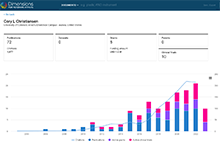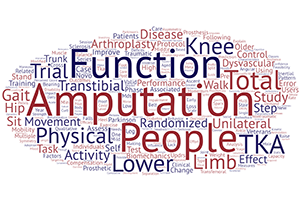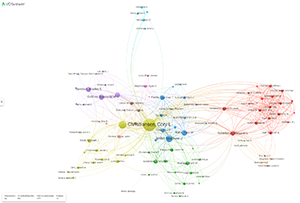Geriatric Research Education and Clinical Center (GRECC)
Eastern Colorado GRECC Team
Home | Research | Education | Clinical | Investigators & Team | Fellowships
Older Veteran Engagement (OVET) | Resources | Contact Us
Investigators & Team Home | Research Interests | Grants/Awards | Publications
Cory Christiansen, PT PhD

Title: EC GRECC Investigator; Professor, Physical Therapy
Contact: cory.christiansen@cuanschutz.edu
University of Colorado webpage
Personal Statement
Dr. Christiansen is an Associate Professor in the Physical Therapy Program. His research focuses on applying rehabilitation science to optimize functional movement outcomes for older adults with a variety of health conditions. Clinical areas of focus for Dr. Christiansen include rehabilitation after total joint arthroplasty and lower limb amputation. He teaches within the Doctor of Physical Therapy and Rehabilitation Science programs, with expertise in Movement Science.
Research Interest

My research is focused on optimizing physical health and life participation outcomes for older adult patient populations with a variety of chronic health conditions. I have been PI or co-I for several randomized controlled rehabilitation studies concentrated on exercise studies and physical activity analysis for a variety of older adult populations, including most recent focus on patients with lower limb amputation. These studies have involved interventions to promote both functional activity and quality of movement, especially related to chronic health and movement behaviors. I have recently led the completion of two pilot studies examining physical activity behavior-change intervention, one for patients recovering from total knee arthroplasty and one for patients with dysvascular lower limb amputation.
The following images visualize Dr. Christiansen's work. The word cloud is drawn from publication titles. The research collaboration map shows research relationships (click the image to enlarge):
| Publications | Grants |
|---|---|
| Clinical Research | Clinical Research |
| Rehabilitation | Rehabilitation |
| Aging | Aging |
| Behavioral and Social Science | Behavioral and Social Science |
| Arthritis | Bioengineering |
| Prevention | Physical Rehabilitation |
| Clinical Trials and Supportive Activities | Assistive Technology |
| Behavioral and Social Science | Chronic Pain |
| Bioengineering | Clinical Trials and Supportive Activities |
| Physical Rehabilitation | Neurosciences |
Grants & Funding
Transfemoral osseointegrated prosthesis limb load symmetry training (TOPLOAD)
Role: Co-PI
This randomized controlled trial will
1) determine the feasibility of a 40-week limb-load biofeedback training intervention,
2) determine if there is an intervention signal of efficacy, and
3) identify functional movement priorities for people with transfemoral osseointegrated prostheses.
Walking Exercise Sustainability Through Telehealth for Veterans with Lower-Limb Amputation
Role: PI
Despite recent advances in physical rehabilitation, Veterans with lower-limb amputation have poor long-term outcomes, including severely limited functional capacity and high levels of disability. Such poor outcomes are compounded by a lack of exercise participation over time, even with lower-limb prostheses.
There is a clear need to advance current rehabilitation strategies to promote sustained exercise following lower-limb amputation. Our study will determine the efficacy of a walking exercise self-management program to achieve sustained exercise participation. The 18-month intervention on helping Veterans reduce habitual sedentary behavior through a remote exercise behavior-change intervention includes multiple clinical disciplines, a novel individualized exercise self-management training, and peer support.
This innovative approach shifts the conventional rehabilitation paradigm to target life-long exercise sustainability and remove an underlying cause of disability for Veterans with lower-limb amputation.
Funder: Veterans Affairs
NIH website
Publications of note:
— Walking Exercise Sustainability through Telehealth (WEST) for Veterans with Lower-Limb Amputation: A Study Protocol
Study in Parkinson disease of exercise Phase III clinical trial: SPARX3
Role: Site-PI
The study goal is to establish the efficacy of high-intensity endurance exercise as first-line therapy for recently diagnosed people with Parkinson's disease (PD).
Optimizing Physical Activity Outcomes for Veterans After Total Knee Arthroplasty
Role: PI; Co-I: Jennifer Stevens-Lapsley
While total knee arthroplasty improves the pain and disability associated with knee osteoarthritis, physical activity levels after total knee arthroplasty remain at low levels and are nearly unchanged from before surgery. Such low physical activity may account for problems seen in Veterans with total knee arthroplasty, including long-term disability, secondary health problems, and high levels of healthcare use.
There is a clear need to advance current rehabilitation strategies to address chronic low physical activity after total knee arthroplasty. Our proposed study will assess the efficacy of using physical activity behavior-change telerehabilitation for improving physical activity outcomes. The three-month intervention focuses on changing habitual behaviors through remote video telerehabilitation sessions between Veterans and physical therapists.
This innovative approach shifts the paradigm of conventional rehabilitation to specifically target poor physical activity behaviors underlying physical disability for Veterans with total knee arthroplasty.
Funder: Veterans Affairs
NIH website
Recruiting ↠ The study Optimizing Physical Activity Outcomes for Veterans After Total Knee Arthroplasty (ART) is recruiting research subjects, click to learn more.
Publications of note:
— Improving Physical Activity Through Adjunct Telerehabilitation Following Total Knee Arthroplasty: Randomized Controlled Trial Protocol
Optimizing Gait Rehabilitation for Veterans with Non-Traumatic Lower Limb Amputation
Role: PI
The population of older Veterans with non-traumatic lower limb amputation is growing. Following lower limb amputation, asymmetrical movements persist during walking and likely contribute to disabling sequelae, including secondary pain conditions, poor gait efficiency, impaired physical function, and compromised skin integrity of the residual limb.
The proposed study seeks to address chronic gait asymmetry by evaluating the efficacy of two error-manipulation gait training programs to improve gait symmetry for Veterans with non-traumatic lower limb amputation. Additionally, this study will assess the potential of error-manipulation training programs to strengthen secondary measures of disability and residual limb skin health.
Ultimately, the proposed study aims to improve conventional prosthetic rehabilitation for Veterans with non-traumatic amputation through gait training programs based on motor learning principles, resulting in improved gait symmetry and lower incidence of long-term disability after non-traumatic lower limb amputation.
Funder: Veterans Affairs
NIH website
Recruiting ↠ The study Optimizing gait rehabilitation for Veterans with non-traumatic lower limb amputation (GEM) is recruiting research subjects, click to learn more.
Publications of note:
— Error-manipulation Gait Training for Veterans with Non-traumatic Lower Limb Amputation: A Randomized Controlled Trial Protocol
Improving health self-management using walking biobehavioral intervention for people with dysvascular lower limb amputation
Role: PI
Sedentary lifestyles and high levels of disability are relevant public and personal health issues resulting from the chronic comorbid condition of dysvascular lower limb amputation.
This study examines the use of an evidence-based walking biobehavioral intervention to increase physical activity after dysvascular amputation.
The proposed intervention leverages successes in conventional prosthetic rehabilitation while addressing the complex health conditions and chronic sedentary behaviors that underlie dysvascular amputation, with the ultimate goal of improved physical activity self-management to minimize disability.
Funder: National Institute of Nursing Research
NIH website
Recruiting ↠ This study is recruiting research subjects, click to learn more.
Movement pattern biofeedback training after total knee arthroplasty
Role: Co-I; PI: Jennifer Stevens-Lapsley
In the next two decades, there may be a significant increase in total knee arthroplasty surgeries. Yet innovative rehabilitation techniques are still needed to optimize long-term physical function.
This study has a high potential to change current rehabilitation practices for TKA. Implementing movement pattern training can be easily implemented in clinical settings. Furthermore, the study also has the unique opportunity to improve patient outcomes after TKA by reducing subsequent problems due to compensatory overuse of the opposite knee.
Funder: National Institute on Aging
NIH website
Publications of note:
— Multimodal conservative management of arthrofibrosis after total knee arthroplasty compared to manipulation under anesthesia: a feasibility study with retrospective cohort comparison
— Movement Pattern Biofeedback Training after Total Knee Arthroplasty: Randomized Clinical Trial Protocol
— The Impact of Home Health Physical Therapy on Medicare Beneficiaries with a Primary Diagnosis of Dementia
Engaging Medically Complex Veterans in Tele-Rehabilitation Using a Biobehavioral Approach: A Pilot Study of Feasibly and Acceptability
Role: Co-I; PI: Jennifer Stevens-Lapsley
Medically complex older Veterans are a vulnerable patient population with reduced access to care (i.e., rural living and limited transportation). This population is also at risk for physical function deficits, physical inactivity, and social isolation.
Telerehabilitation is a potentially effective and scalable approach for providing rehabilitation services to medically complex older Veterans with limited care access. This study will determine the feasibility, acceptability, and safety of a multicomponent telerehabilitation program strategically designed to address the physical function deficits and social isolation often experienced by older Veterans.
Study findings will have an immediate clinical impact as they will guide the implementation of safe and effective telerehabilitation strategies for medically complex older Veterans who lack access to standard in-person rehabilitation services.
Funder: Veterans Affairs
NIH website
Recent Publications
2024
Vinson AL, Vandenberg NW, Awad ME, Christiansen CL, Stoneback JW, M M Gaffney B. The biomechanical influence of transtibial Bone-Anchored limbs during walking. J Biomech. 2024 Apr 15;168:112098. doi: 10.1016/j.jbiomech.2024.112098. Epub ahead of print.
PMID: 38636112.
Learn more about this publication on Dimensions
Awad ME, Melton D, Shaw KG, Lev G, Gaffney BMM, Christiansen CL, Stoneback JW. How Comprehensive and Efficient Are Patient-Reported Outcome Measures for Individuals with Lower Extremity Amputation Undergoing Implantation of Osseointegrated Bone Anchored Limbs? JBJS Rev. 2024 Mar 15;12(3). doi: 10.2106/JBJS.RVW.23.00235.
PMID: 38489397.
Learn more about this publication on Dimensions
Mañago MM, Will R, Strahler T, Van Valkenburgh L, Harris-Love MO, Forster JE, Cameron M, Christiansen CL. Blood Flow Restriction and Veterans with Multiple Sclerosis (BRaVe-MS) and Advanced Disability: Protocol for a Randomized Controlled Trial. Phys Ther. 2024 Mar 7:pzae037. doi: 10.1093/ptj/pzae037. Epub ahead of print.
PMID: 38452199.
Learn more about this publication on Dimensions
Gaffney BMM, Thomsen PB, Leijendekkers RA, Christiansen CL, Stoneback JW. Lumbopelvic movement coordination during walking improves with transfemoral bone anchored limbs: Implications for low back pain. Gait Posture. 2024 Feb 24;109:318-326. doi: 10.1016/j.gaitpost.2024.02.015. Epub ahead of print.
PMID: 38432038.
Learn more about this publication on Dimensions
Griffith G, Lamotte G, Mehta N, Fan P, Nikolich J, Springman V, Suttman E, Joslin E, Balfany K, Dunlap M, Kohrt WM, Christiansen CL, Melanson EL, Josbeno D, Chahine LM, Patterson CG, Corcos DM. Chronotropic Incompetence During Exercise Testing as a Marker of Autonomic Dysfunction in Individuals with Early Parkinson's Disease. J Parkinsons Dis. 2024 Jan 4. doi: 10.3233/JPD-230006. Epub ahead of print.
PMID: 38189712.
Learn more about this publication on Dimensions
2023
Judd DL, Cheuy V, Peters A, Graber J, Hinrichs-Kinney L, Forster JE, Christiansen CL, Stevens-Lapsley JE. Incorporating Functional Strength Integration Techniques during Total Hip Arthroplasty Rehabilitation: A Randomized Controlled Trial. Phys Ther. 2023 Dec 15:pzad168. doi: 10.1093/ptj/pzad168. Epub ahead of print.
PMID: 38102757.
Learn more about this publication on Dimensions
Roda GF, Awad ME, Melton DH, Christiansen CL, Stoneback JW, Gaffney BMM. The Amputated Limb Gluteus Medius is Biomechanically Disadvantaged in Patients with Unilateral Transfemoral Amputation. Ann Biomed Eng. 2023 Nov 9. doi: 10.1007/s10439-023-03400-0. Epub ahead of print.
PMID: 37946055.
Learn more about this publication on Dimensions
Swink LA, Mealer ML, Miller MJ, Anderson CB, Cook PF, Stevens-Lapsley JE, Christiansen CL. Telehealth Walking Self-Management for Individuals with Amputation: A Qualitative Study of Therapist Perspectives on Adoption. Phys Ther. 2023 Nov 7:pzad155. doi: 10.1093/ptj/pzad155. Epub ahead of print.
PMID: 37944092.
Learn more about this publication on Dimensions
Hoffman RM, Davis-Wilson HC, Hanlon S, Swink LA, Kline PW, Juarez-Colunga E, Melanson EL, Christiansen CL. Maximal Daily Stepping Cadence Partially Explains Functional Capacity of Individuals with End-Stage Knee Osteoarthritis. PM R. 2023 Oct 11. doi: 10.1002/pmrj.13082. Epub ahead of print.
PMID: 37819260.
Learn more about this publication on Dimensions
Hanlon SL, Swink LA, Akay RB, Fields TT, Cook PF, Gaffney BMM, Juarez-Colunga E, Christiansen CL. Walking Exercise Sustainability through Telehealth (WEST) for Veterans with Lower-Limb Amputation: A Study Protocol. Phys Ther. 2023 Aug 24:pzad112. doi: 10.1093/ptj/pzad112. Epub ahead of print.
PMID: 37615982.
Learn more about this publication on Dimensions
Vandenberg NW, Stoneback JW, Davis-Wilson H, Christiansen CL, Awad ME, Melton DH, Gaffney BMM. Unilateral transfemoral osseointegrated prostheses improve joint loading during walking. J Biomech. 2023 May 26;155:111658. doi: 10.1016/j.jbiomech.2023.111658. Epub ahead of print.
PMID: 37276681.
Learn more about this publication on Dimensions
Gaffney BMM, Davis-Wilson HC, Awad ME, Tracy J, Melton DH, Lev G, Stoneback JW, Christiansen CL. Daily steps and stepping cadence increase one-year following prosthesis osseointegration in people with lower-limb amputation. Disabil Rehabil. 2023 Apr 19:1-6. doi: 10.1080/09638288.2023.2200036. Epub ahead of print.
PMID: 37073780.
Learn more about this publication on Dimensions
Davis-Wilson HC, Christiansen CL, Gaffney BMM, Lev G, Enabulele E, Hoyt C, Stoneback JW. Changes in lower extremity joint moments one-year following osseointegration in individuals with Transfemoral lower-limb amputation: A case series. Clin Biomech (Bristol, Avon). 2023 Mar 27;104:105948. doi: 10.1016/j.clinbiomech.2023.105948. Epub ahead of print.
PMID: 37043833.
Learn more about this publication on Dimensions
Mañago MM, Cohen ET, Cameron MH, Christiansen CL, Bade M. Reliability, Validity, and Responsiveness of the Patient-Specific Functional Scale for Measuring Mobility-Related Goals in People With Multiple Sclerosis. J Neurol Phys Ther. 2023 Mar 8. doi: 10.1097/NPT.0000000000000439. Epub ahead of print.
PMID: 36897202.
Learn more about this publication on Dimensions
2022
Davis-Wilson HC, Christiansen CL, Gaffney BMM, Lev G, Enabulele E, Stoneback JW. Improvements in disability and function in people with lower-limb amputation one year after prosthesis osseointegration. Prosthet Orthot Int. 2022 Dec 27. doi: 10.1097/PXR.0000000000000200. Epub ahead of print. PMID: .
PMID: 36701203.
Learn more about this publication on Dimensions
Gaffney BMM, Davis-Wilson HC, Christiansen CL, Awad ME, Lev G, Tracy J, Stoneback JW. Osseointegrated prostheses improve balance and balance confidence in individuals with unilateral transfemoral limb loss. Gait Posture. 2022 Dec 13;100:132-138. doi: 10.1016/j.gaitpost.2022.12.011. Epub ahead of print.
PMID: 36521257.
Learn more about this publication on Dimensions
Patterson CG, Joslin E, Gil AB, Spigle W, Nemet T, Chahine L, Christiansen CL, Melanson E, Kohrt WM, Mancini M, Josbeno D, Balfany K, Griffith G, Dunlap MK, Lamotte G, Suttman E, Larson D, Branson C, McKee KE, Goelz L, Poon C, Tilley B, Kang UJ, Tansey MG, Luthra N, Tanner CM, Haus JM, Fantuzzi G, McFarland NR, Gonzalez-Latapi P, Foroud T, Motl R, Schwarzschild MA, Simuni T, Marek K, Naito A, Lungu C, Corcos DM; SPARX3-PSG Investigators. Study in Parkinson's disease of exercise phase 3 (SPARX3): study protocol for a randomized controlled trial. Trials. 2022 Oct 6;23(1):855. doi: 10.1186/s13063-022-06703-0. PMCID: PMC9535216.
PMID: 36203214.
Learn more about this publication on Dimensions
Kline PW, Davis-Wilson HC, So NF, Fields TT, Christiansen CL. Feasibility of repeated session error-augmentation gait training for people with nontraumatic transtibial amputation. Prosthet Orthot Int. 2022 Aug 25. doi: 10.1097/PXR.0000000000000181. Epub ahead of print.
PMID: 36037273.
Learn more about this publication on Dimensions
Anderson CB, Fatone S, Mañago MM, Swink LA, Hager ER, Kittelson AJ, Christiansen CL, Magnusson DM. Improving shared decision-making for prosthetic care: a qualitative needs assessment of prosthetists and new lower-limb prosthesis users. Prosthet Orthot Int. 2022 May 25. doi: 10.1097/PXR.0000000000000142. Epub ahead of print.
PMID: 35622457.
Learn more about this publication on Dimensions
Anderson CB, Kittelson AJ, Wurdeman SR, Miller MJ, Stoneback JW, Christiansen CL, Magnusson DM. Understanding decision-making in prosthetic rehabilitation by prosthetists and people with lower limb amputation: a qualitative study. Disabil Rehabil. 2022 Apr 7:1-10. doi: 10.1080/09638288.2022.2037745. Epub ahead of print.
PMID: 35389313.
Learn more about this publication on Dimensions
Miller MJ, Hoffman RM, Swink LA, Barnes DE, Christiansen CL. Post-amputation cognitive impairment is related to worse perceived physical function among middle age and older prosthesis users. Arch Phys Med Rehabil. 2022 Feb 3:S0003-9993(22)00022-3. doi: 10.1016/j.apmr.2021.12.025. Epub ahead of print.
PMID: 35123974.
Learn more about this publication on Dimensions
Kline PW, Christiansen CL, Judd DL, Mañago MM. Clinical utility of the Trendelenburg Test in people with multiple sclerosis. Physiother Theory Pract. 2022 Jan 24:1-8. doi: 10.1080/09593985.2022.2030446. Epub ahead of print.
PMID: 35073816.
Learn more about this publication on Dimensions
2021
Mañago MM, Swink LA, Hager ER, Gisbert R, Earhart GM, Christiansen CL, Schenkman M. The Impact of COVID-19 on Community-Based Exercise Classes for People with Parkinson Disease. Phys Ther. 2021 Aug 27:pzab203. doi: 10.1093/ptj/pzab203. Epub ahead of print.
PMID: 34473303.
Learn more about this publication on Dimensions
Kline PW, So N, Fields T, Juarez-Colunga E, Christiansen CL. Error-Manipulation Gait Training for Veterans with Non-Traumatic Lower Limb Amputation: A Randomized Controlled Trial Protocol. Phys Ther. 2021 Aug 9:pzab192. doi: 10.1093/ptj/pzab192. Epub ahead of print.
PMID: 34379777.
Learn more about this publication on Dimensions
Christensen JC, Quammen DL, Rigby JH, Christiansen CL, Stevens-Lapsley JE. Trunk movement compensation identified by inertial measurement units is associated with deficits in physical performance, muscle strength and functional capacity in people with hip osteoarthritis. Clin Biomech (Bristol, Avon). 2021 Jul 21;88:105436. doi: 10.1016/j.clinbiomech.2021.105436. Epub ahead of print.
PMID: 34364100.
Learn more about this publication on Dimensions
Mañago MM, Kline PW, Harris-Love MO, Christiansen CL. The Validity of the Single-Leg Heel Raise Test in People With Multiple Sclerosis: A Cross-Sectional Study. Front Neurol. 2021 Jul 21;12:650297. doi: 10.3389/fneur.2021.650297. PMCID: PMC8333614.
PMID: 34354656.
Learn more about this publication on Dimensions
Kline PW, Christiansen CL, Hager ER, Alvarez E, Mañago MM. Movement compensations during a step ascent task are associated with stair climbing performance in people with multiple sclerosis. Gait Posture. 2021 Apr 15;87:27-32. doi: 10.1016/j.gaitpost.2021.04.022. Epub ahead of print.
PMID: 33878510.
Learn more about this publication on Dimensions
Anderson CB, Wurdeman SR, Miller MJ, Christiansen CL, Kittelson AJ. Development of a physical mobility prediction model to guide prosthetic rehabilitation. J Dev Behav Pediatr. 2021 Apr 5. doi: 10.1097/PXR.0000000000000001. Epub ahead of print.
PMID: 33840752.
Learn more about this publication on Dimensions
Miller MJ, Mealer ML, Cook PF, Kittleson AJ, Christiansen CL. Psychometric Assessment of the Connor-Davidson Resilience Scale for People With Lower-Limb Amputation. Phys Ther. 2021 Jan 9:pzab002. doi: 10.1093/ptj/pzab002. Epub ahead of print.
PMID: 33421074.
Learn more about this publication on Dimensions
2020
Miller MJ, Blankenship JM, Kline PW, Melanson EL, Christiansen CL. Patterns of Sitting, Standing, and Stepping After Lower Limb Amputation. Phys Ther. 2020 Dec 17:pzaa212. doi: 10.1093/ptj/pzaa212. Epub ahead of print.
PMID: 33336706.
Learn more about this publication on Dimensions
Miller MJ, Cook PF, Magnusson DM, Morris MA, Blatchford PJ, Schenkman ML, Christiansen CL. Self-Efficacy and Social Support are Associated with Disability for Ambulatory Prosthesis Users After Lower-Limb Amputation. PM R. 2020 Aug 10. doi: 10.1002/pmrj.12464. Epub ahead of print.
PMID: 32926546.
Learn more about this publication on Dimensions
Miller MJ, Morris MA, Magnusson DM, Putnam K, Cook PF, Schenkman ML, Christiansen CL. Psychosocial Factors Influence Physical Activity after Dysvascular Amputation: A Convergent Mixed-Methods Study. PM R. 2020 Aug 10. doi: 10.1002/pmrj.12466. Epub ahead of print.
PMID: 32936512.
Learn more about this publication on Dimensions
Christensen JC, Kline PW, Murray AM, Christiansen CL. Movement asymmetry during low and high demand mobility tasks after dysvascular transtibial amputation [published online ahead of print, 2020 Jul 7]. Clin Biomech (Bristol, Avon). 2020;80:105102. doi:10.1016/j.clinbiomech.2020.105102
PMID: 32768801.
Learn more about this publication on Dimensions
Kline PW, Murray AM, Miller MJ, So N, Fields T, Christiansen CL. Step length symmetry adaptation to split-belt treadmill walking after acquired non-traumatic transtibial amputation. Gait Posture. 2020 Jul; 80:162-167.
PMID: 32516682.
Learn more about this publication on Dimensions





















